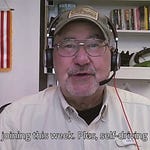Bang! The smell of spent gunpowder wafted across the field from my left side. Eyes forward, I followed the tiny, bouncing white ball that kicked some 20 feet. “Nice shot!” I said. Then, “I want to hear that safety go on before you move!”
I couldn’t help myself. It’s a Dad thing to say.
A faint Click! from somewhere abaft the port beam.
“Okay. My turn,” I said, and began a stealthy move toward where I had last seen the golf ball. Spying it hiding in the recently harvested prairie grass, I shouldered the Winchester .22 Trapper model I carried and cranked the lever. The target nestled down into the front site and I slowly pressed the trigger.
The gun recoiled ever so slightly with the report. A lightweight 36-grain Armscor hollow point struck the earth a quarter-inch behind and below the target at 1,100 feet per second. Obeying Newton’s iron-clad Third Law of Motion, the ball jumped satisfyingly into the air, sailing forward 10 yards.
We moved up quietly, hunter-killers that we were, and it was his turn again.
The golf ball, following its unique 120-year-old design, appears to be based on the geometry of a truncated icosohedron. The dimples make “a turbulent layer around the ball creating a low pressure leading edge,” thus promoting less drag in the air. This makes for better yardage.
Distances, however, are much better with a 3-wood golf club than with a .22 rimfire rifle.
Gunning for golf balls
I think he was not quite 11 that year, when I decided my older son and I needed some time afield with firearms. (I can almost hear the audible gasps among the readership. Fret not thyself; I know what I’m doing. Or so shall I claim.)
I’ve never been much of a golfer, being more at home with a chainsaw than a 5-iron. This was probably a disservice to my sons, but one plays the hand that one is dealt. With the acquisition of rural farmland in the Flint Hills of Kansas, we immersed ourselves in the entertainment offered: four-wheelers, fishing rods, chainsaws and guns.
Once the hay had been harvested from the north pasture, grass was short enough for rimfire golf.
The rules of the game
Two — and only two, for safety — players line up abreast, 10 feet apart, with loaded .22 rifles, ear and eye protection. Dad tosses a golf ball out into the grass. We both stalk up to within 20 feet of it; by agreement, one of us chambers a live round, draws a bead and shoots at the ball.
Best to have a half-mile of unoccupied land out front before this happens. Lightweight bullets can ricochet unexpectedly and tragically.
If the shooter misses, he safes the gun and the other one shoots. This goes on until one of us expert marksmen connects. Then, safeties engaged, we move forward and repeat the process.
I suppose we could have kept score, but that was hardly the point. Seeing the ball kick up in the air is reward enough.
Both being right-handers, I always placed the novice shooter on my left side. It is far easier to unthinkingly swing a rifle to the weak (left-hand) side than to the strong. I had no interest in being flagged with a muzzle by an inexperienced shooter.
(Side note for the gun aficianado: The lever gun is much safer for training a new shooter. Once it goes “bang,” it is no longer loaded until the lever is cycled. The semi-auto, by contrast, is loaded again as soon as the trigger is pulled. This makes engaging the manual safety critical. From time to time I assigned the semi-auto to the trainee, for the sake of familiarization. It adds a fine edge of real danger to his experience, and — it is hoped — significantly heightens his attention level.)
Learning lessons for value
Learning new activities adds energy to life. In the case of raising boys in a rural area, the use of firearms was a natural pursuit.
Besides the entertainment value, there was a long-term safety issue on my mind as well. I knew that at some time in his life, my son would likely be in the presence of a firearm. When that occurred, I wanted him to be most experienced person in the room.
But beyond pure survival, it was about developing competence in a new arena. Lifelong learning has to start someplace.
I wrote of this in an article on a different substack publication. My Dad, a consummate blue-collar mechanic, farmer and Navy Chief, took up sewing after age 65. He needed a few fabric-based items designed to specifications that could not be found in any store. He figured, Why not make them myself?
So he did. Read about it here.
The rewards of learning
Rimfire golf paid dividends:
It offered a father-and-son activity that put us in each others’ company without the distraction of an amusement park or citified equivalent.
It gave me the excuse to train the responsible use of firearms.
It was not an activity sugar-fueled or fattening.
It was an excuse to buy some really cool guns.
It afforded the chance to demonstrate how to clean and care for the guns, and keep them isolated, locked up in a safe. Guns in one cabinet, ammunition in another.
Today, both boys are training the next generation in the proper use of guns. This makes everyone safer. And probably more free.
This is America, after all.
Thanks for joining The Alligator Blog. Don’t forget to Like and Share. Someone you know may appreciate the encouragement.















Share this post